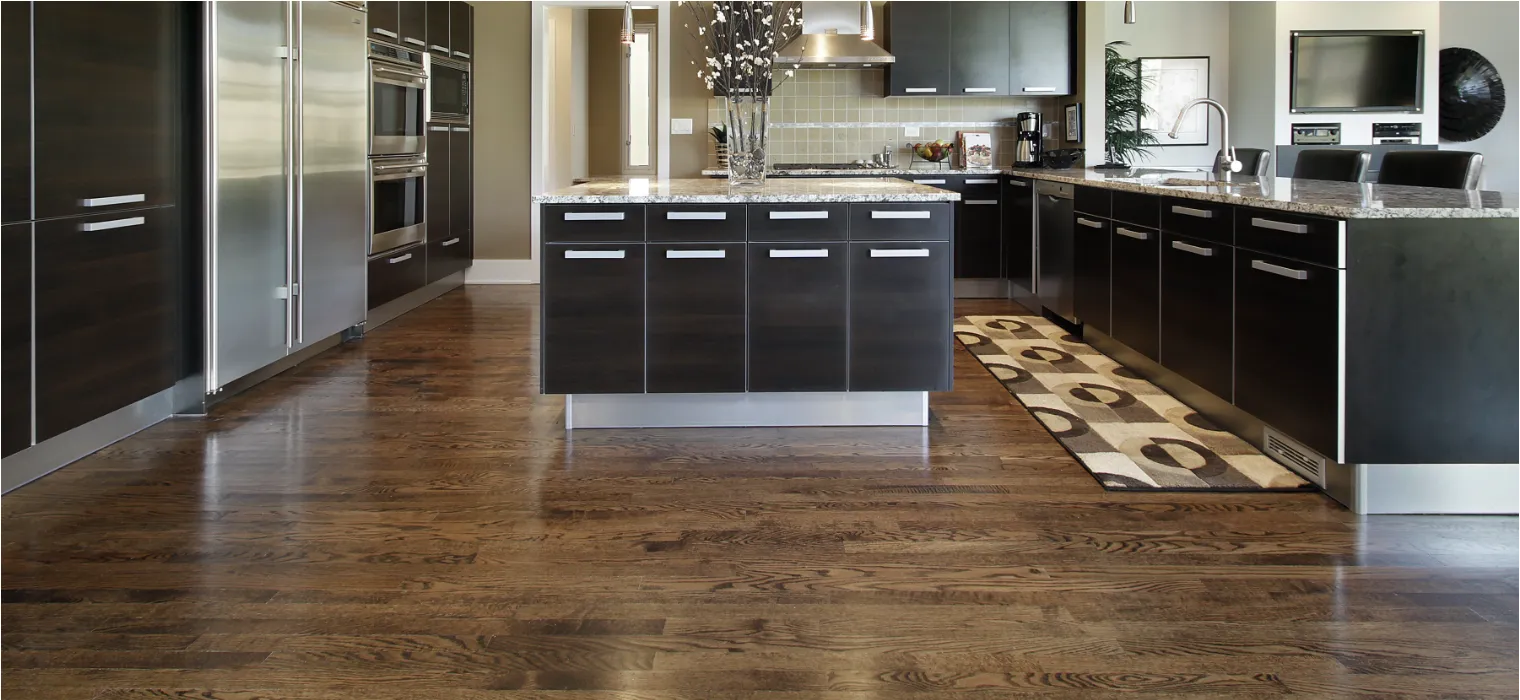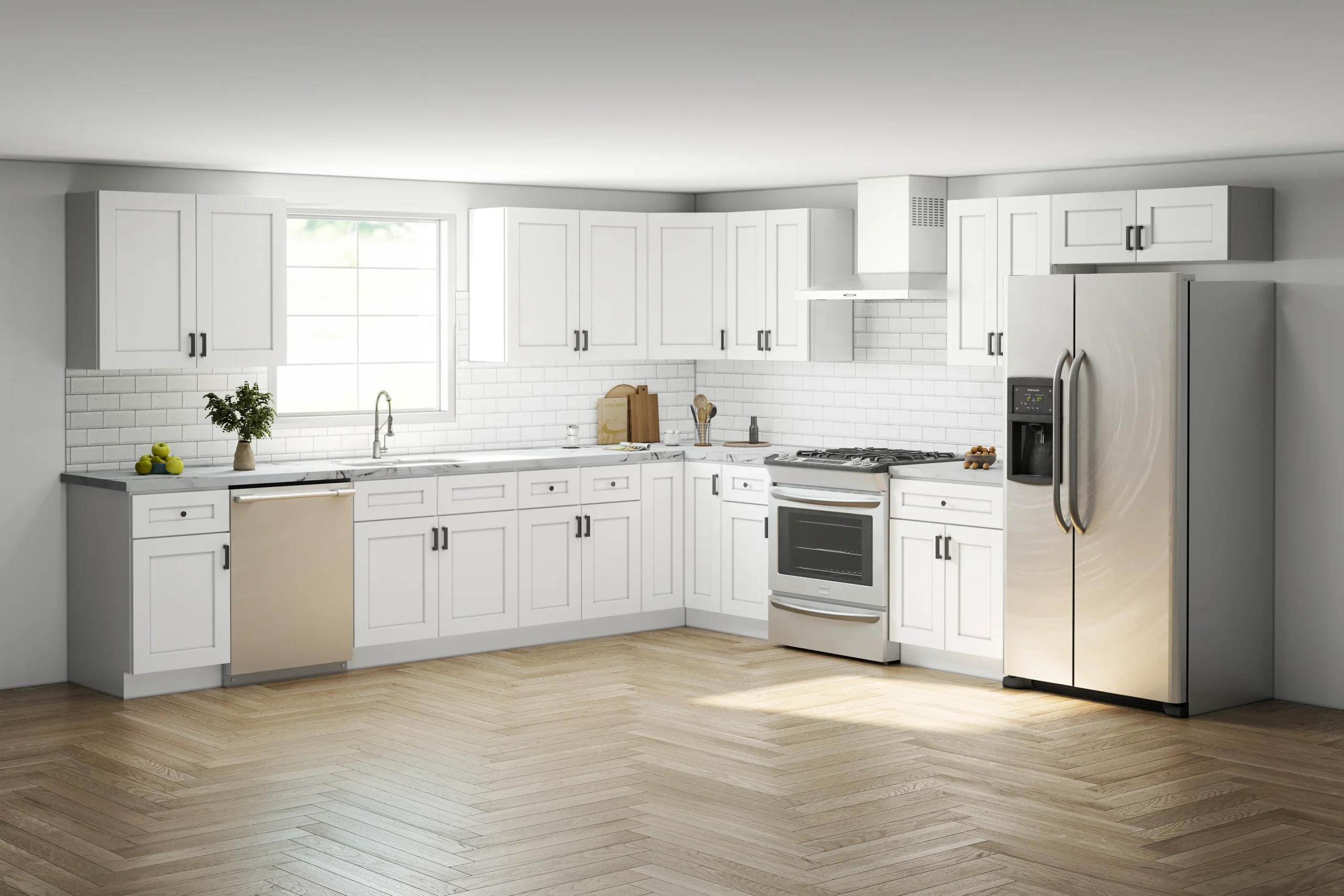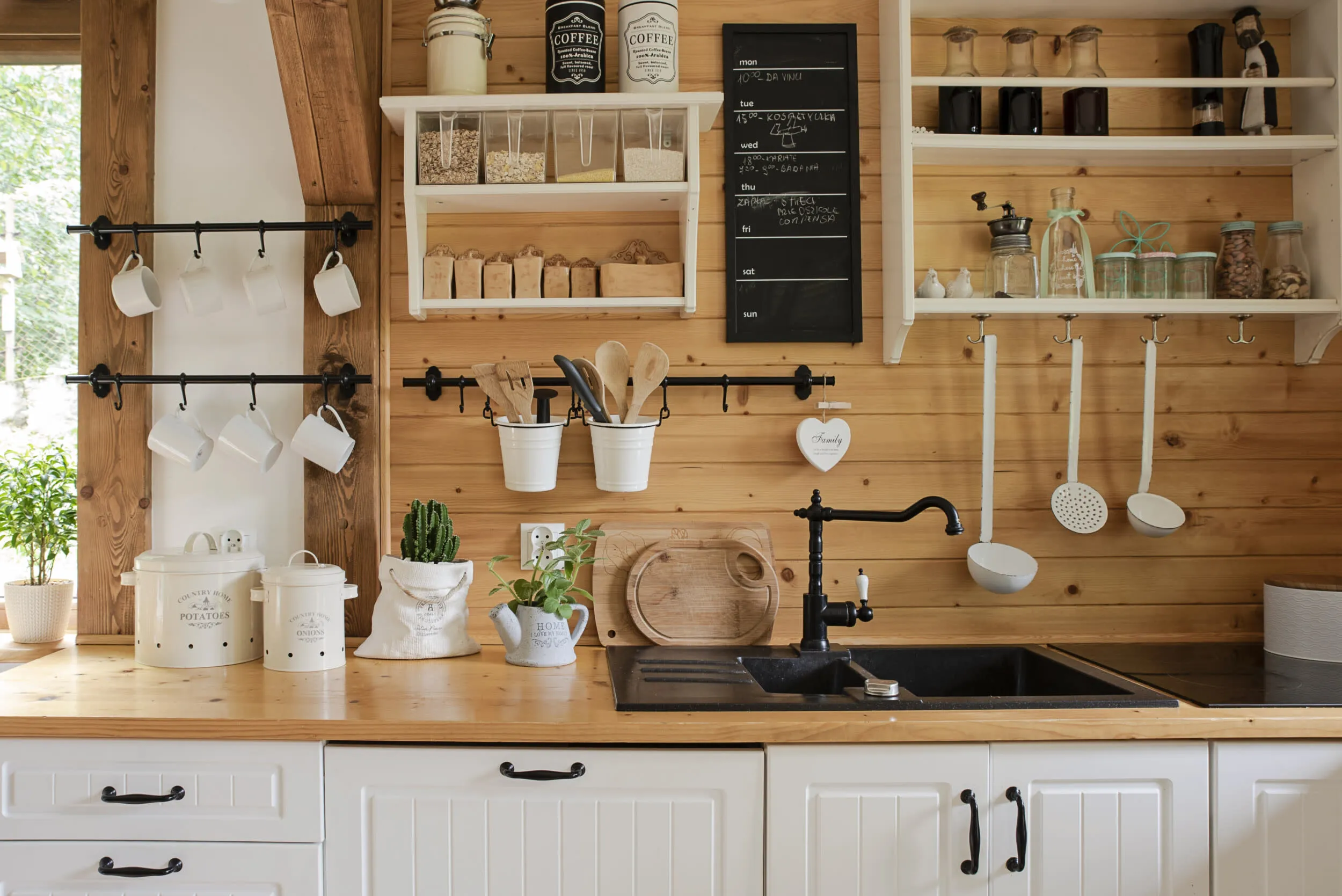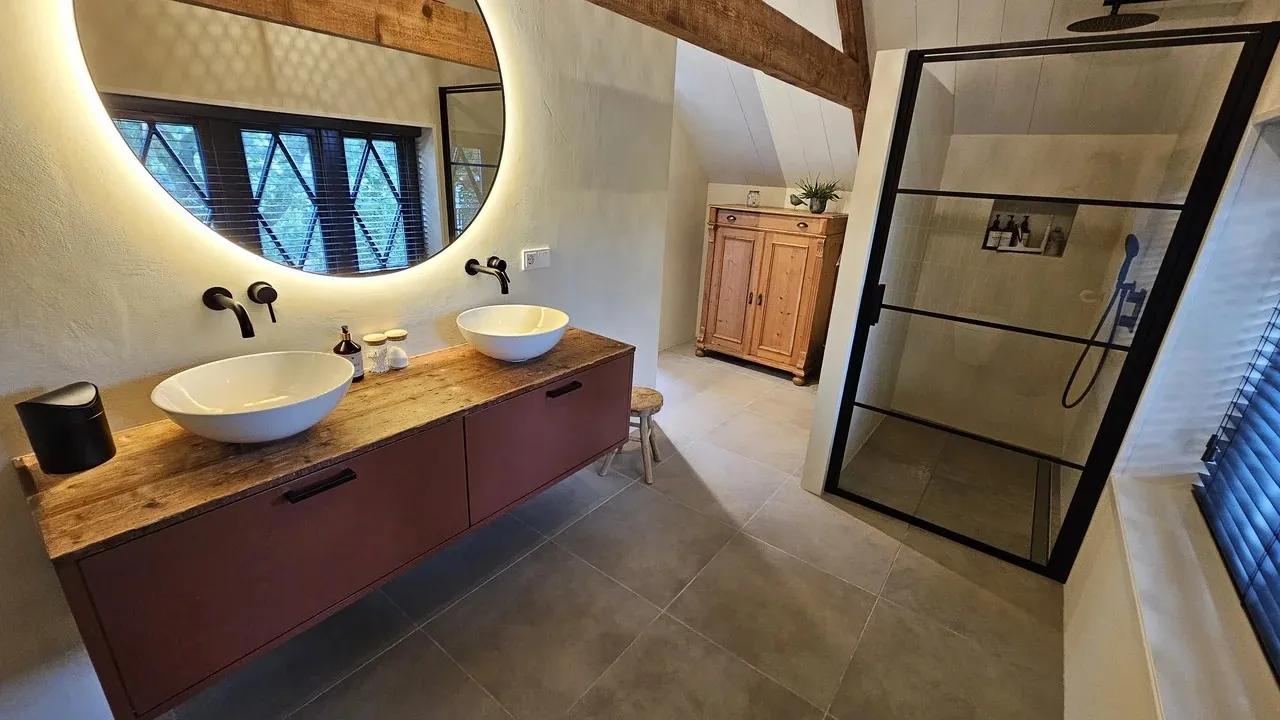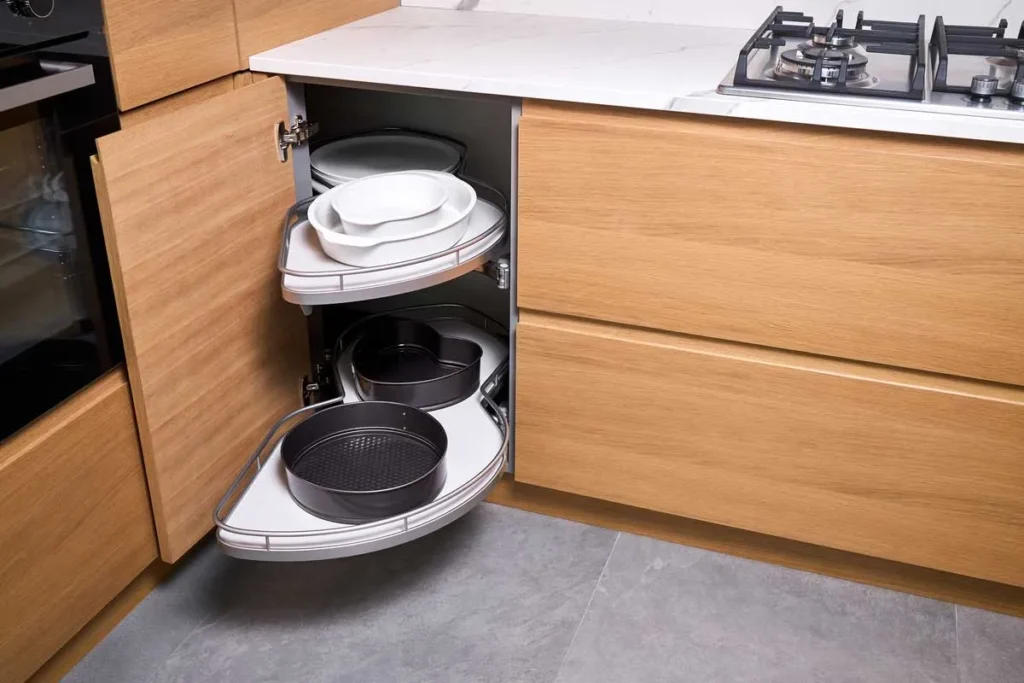
Clutter hides in corners. Things vanish. You bend, reach, and give up. That corner can work harder—and look better—without another spinning tray.
You are not stuck with a lazy Susan. Smarter corner ideas include corner drawers, blind-corner pullouts, LeMans and Magic Corner trays, diagonal cabinets, a corner sink base, a tall corner pantry, and an appliance garage. Pick by layout, reach, and budget.
This guide shows what each option does well, what to watch for, and where it fits. Use the quick tables, then go deeper for measurements, workflow, and real-world trade-offs.
What problems do kitchen corners usually create?
Corners swallow pots, block workflow, and waste light. You bend, twist, and still cannot see. Doors crash into handles. Trays jam when items tip.
Corners feel tight because access is poor, not because space is small. Choose solutions that fix reach, sight, and motion—then storage volume follows. Corners should reduce steps, not add them.
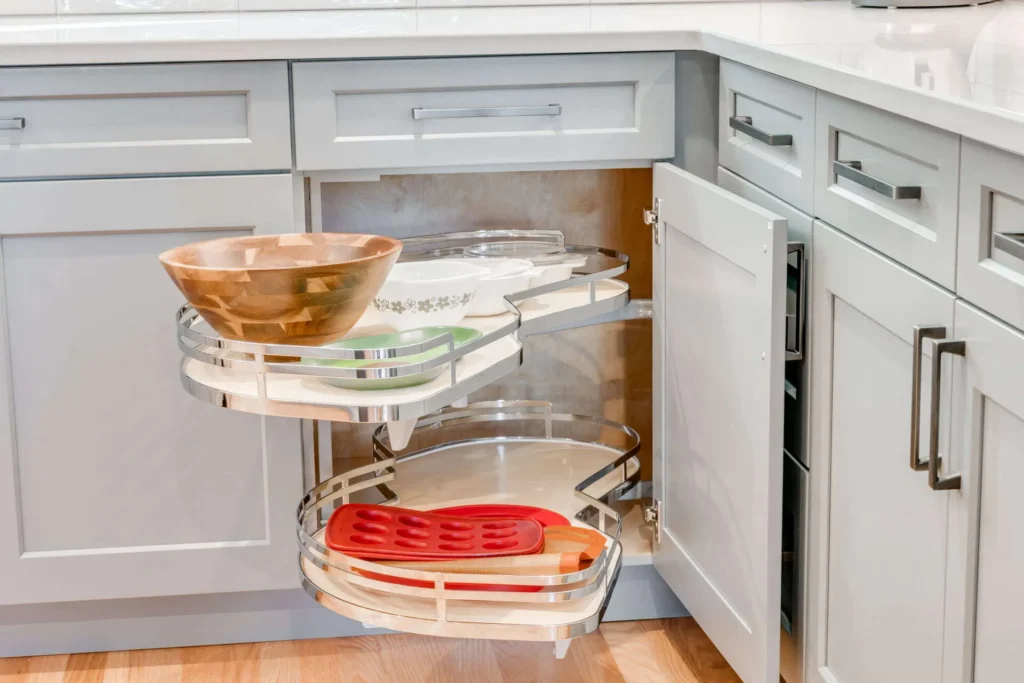
Why corners fail
- Access: You can’t see the back.
- Motion: Doors and trays conflict with appliances.
- Load: Round trays waste edges and lose height.
- Light: Dark voids make items invisible.
27 smart ways at a glance
| # | Corner idea | Best for | Big pro | Watch-out |
| 1 | Super Susan (no center pole) | Heavy pots | Simple, sturdy | Needs wide door |
| 2 | Corner drawers (stack) | Everyday items | Full extension | Precise sizing |
| 3 | Blind-corner pullout system | Deep corners | Brings items out | Door clearance |
| 4 | LeMans trays | Tall/heavy gear | Smooth reach | Price |
| 5 | Magic Corner | Mixed items | Great ergonomics | Height limits |
| 6 | Diagonal corner base | Big items | Simple shelves | Door swing |
| 7 | Half-moon pullouts | Retrofits | Easy add-on | Lower capacity |
| 8 | Pie-cut shelves | Budget | Familiar | Wasted edges |
| 9 | D-shaped trays | Round items | Stable rim | Door width |
| 10 | Corner recycle center | Sorting | Dedicated bins | Odor control |
| 11 | Corner spice tiers | Small jars | Fast access | Labeling needed |
| 12 | Corner tray dividers | Sheets & trays | Vertical storage | Tall door |
| 13 | Mixer lift in corner | Bakers | Safe lift | Power outlet |
| 14 | Corner sink base | Workflow | Frees runs | Plumbing layout |
| 15 | Corner coffee station | Daily use | All-in-one | Steam clearance |
| 16 | Appliance garage (tambour) | Toasters/blenders | Hide clutter | Counter depth |
| 17 | Open corner shelves | Displayware | Airy look | Dust |
| 18 | Glass-front upper corner | Lighting | Bright corners | Glass care |
| 19 | Tall corner pantry | Bulk goods | Huge volume | Door swing |
| 20 | Swing-out pantry arms | Fast access | Everything visible | Weight limits |
| 21 | Rolling bins in base | Kids’ snacks | Grab-and-go | Floor protection |
| 22 | Pegboard base organizer | Pots & lids | Custom fit | Setup time |
| 23 | Deep toe-kick drawer | Sheets/pans | Hidden storage | Low height |
| 24 | Corner wine rack | Bottles | Fixed grid | Temp/light |
| 25 | LED corner lighting | Any corner | Visibility | Wiring |
| 26 | Label + bin strategy | Small items | Clarity | Discipline |
| 27 | Adjustable shelves | Flexible use | Cheap & quick | Not ergonomic |
Are lazy Susans still the best corner solution?
Lazy Susans help, but they are not the only path. Super Susans, drawers, and pullouts often store more and reach better with fewer jams.
Use a lazy Susan when budget is tight and items are round or light. For heavy cookware, consider a Super Susan or drawers. For deep blind corners, choose a pullout or LeMans for full access.
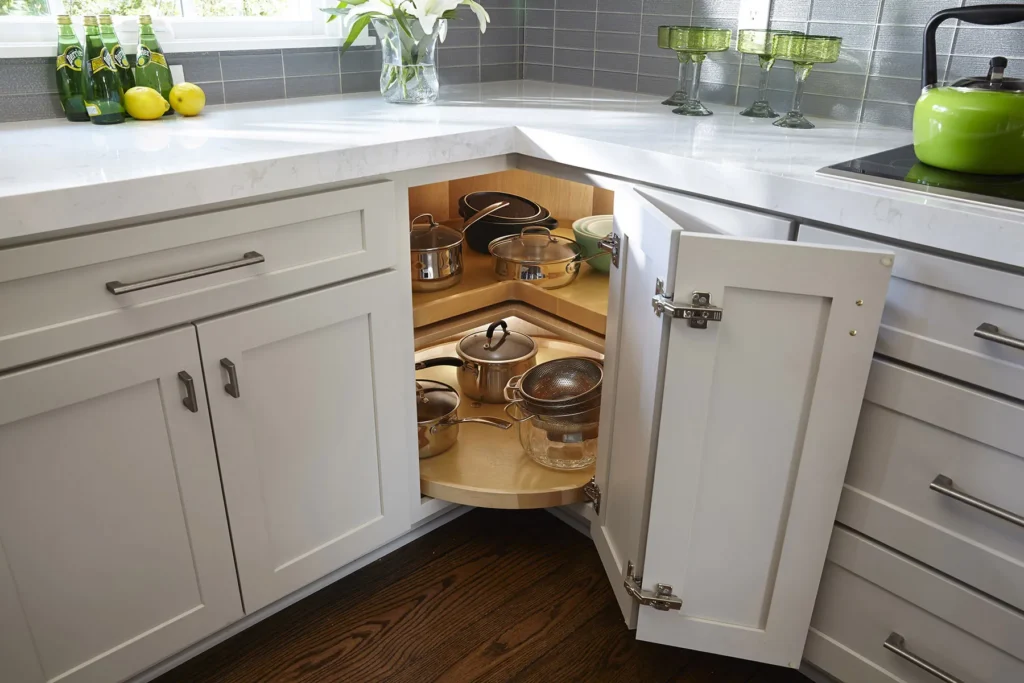
Go deeper
Fit and reach. A classic lazy Susan rotates, but it keeps round trays in a square box. Edges waste space, and the center pole blocks tall stockpots. A Super Susan removes the pole and uses fixed shelves with independent turntables, so dropped items do not fall into a void and capacity improves. For short items (snacks, wraps, plastic containers), a standard Susan can be fine. For tall, heavy items, a Super Susan or corner drawers are better.
Longevity. Fewer moving parts mean fewer problems. Pole bearings and plastic trays can wobble under load. Super Susan shelves are stronger. Drawer runners rated 75–100 lb feel solid for years if installed well.
Workflow. Spinning trays can open to a dead angle when a range or dishwasher sits close. Drawers pull straight toward you, so they clear adjacent handles more easily. A blind-corner pullout brings contents fully into the light and keeps the door motion predictable.
Budget. Classic Susans are the entry-level pick. Super Susans and pullouts cost more but give better reach per dollar. If you cook often, the time saved adds up.
Corner drawers vs blind corner pullouts: which wins?
Drawers give the fastest access for daily items. Pullouts win for deep corners and mixed sizes. Think about what you store, then pick the motion you need.
Choose drawers for plates, bowls, and cookware used every day. Pick pullouts for deep, hidden space and heavier gear that must come fully out to view and lift.
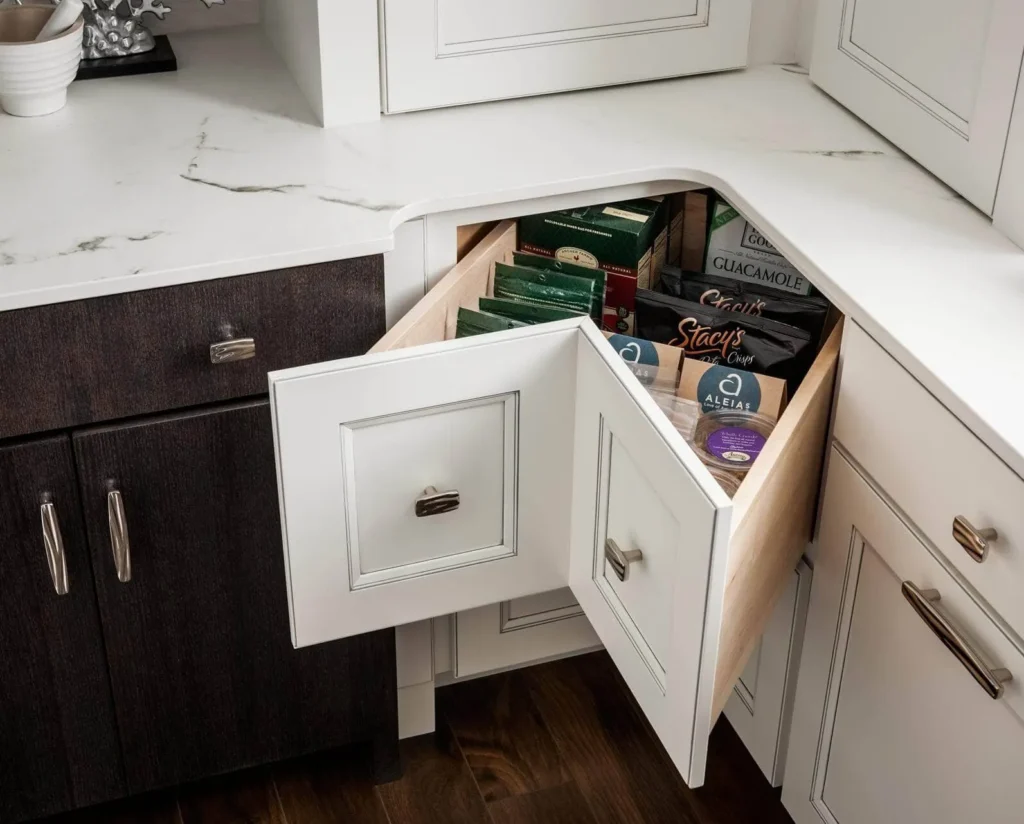
Compare side by side
| Aspect | Corner drawers | Blind-corner pullout |
| Access speed | Highest | High once open |
| Use of depth | Good near face | Excellent to back |
| Load rating | High with quality slides | High; check specs |
| Retrofit | Hard | Medium (kit options) |
| Door clearance | Simple | Needs precise angles |
| Cost | Medium–High | Medium–High |
Go deeper
Ergonomics. Corner drawers keep your stance square to the counter. Full-extension runners show everything at once. You bend less, and heavy pots slide out at waist height. Pullouts use linked trays: you open the door, then swing or slide trays out. This two-step motion is still smooth, but setup matters—hinge angles and handle clearances must be right or trays catch.
Capacity. Drawers use triangular boxes; the fronts are wide, but the backs narrow. They hold stacks of plates, lids, wraps, or mixing bowls well. Pullouts exploit the hidden back zone. A two-tier blind-corner pullout can carry tall stockpots, Dutch ovens, and small appliances you do not need daily.
Install. Drawers need precise cabinet boxes and quality slides. They are best when planned at design time. Pullout kits can retrofit many blind corners. Measure door width, interior depth, and hinge angle (often 45° or 90°). Follow the manufacturer’s min/max specs.
Costs and choices. Both sit in the same band, but drawer boxes plus premium slides can push higher. Pullouts vary by brand and load rating. If your corner sits near a range or fridge, test the door swing and tray path before ordering.
Is a LeMans corner unit worth it?
Yes, if you need smooth reach for heavy gear. The tray shape sweeps items out in one motion, keeping them level. It feels premium and saves your back.
LeMans trays suit tall pots, mixers, and heavy pans. They cost more than basic pullouts but load ratings and movement are strong. Check door width and hinge angles before you commit.
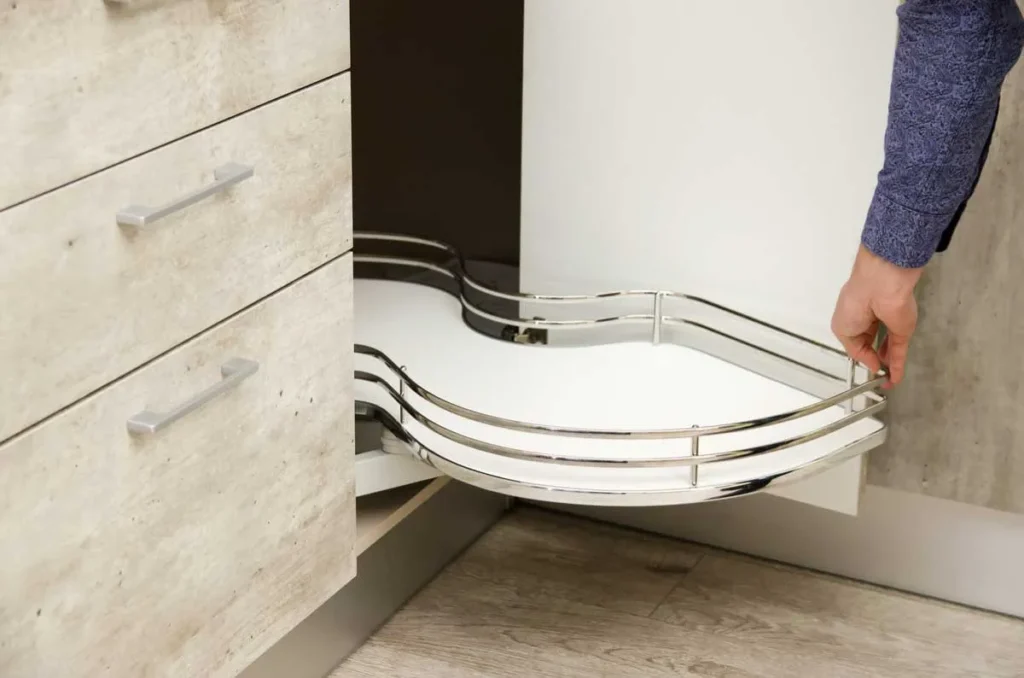
Go deeper
How it moves. A LeMans tray follows an S-curve: it clears the opening, then glides forward so you lift items in bright light. The tray remains flat, so liquids and stand mixers stay steady. Compared with a Magic Corner, LeMans often allows taller items because the tray shape is elongated, not stacked.
What it carries. Many LeMans systems hold 50–60 lb per tray. That covers cast-iron, blender bases, or a pressure cooker. Height tends to beat other systems, which like horizontal space but limit vertical clearance.
Space and planning. You need the right door width, hinge type, and handle placement. The sweep path must avoid appliance knobs and nearby pulls. In a tight galley, open the door and simulate the arc with tape to confirm clearance. Plan outlets if you park powered gear on trays.
Who benefits. Busy cooks who hate crouching. People who batch-cook with heavy pots. Those who want a quiet, one-hand motion. If your budget is tight or items are light, a blind-corner pullout or Magic Corner may satisfy at lower cost. If you need height and strength, LeMans is often worth it.
Do corner sinks improve workflow and storage?
A corner sink frees both runs of counter and keeps prep in one spot. It can fix tight L-shapes. But it steals base storage and needs careful lighting.
Use a corner sink if you value counter space and want prep near two walls. Avoid it if you need maximum base storage or have small windows and dark corners.
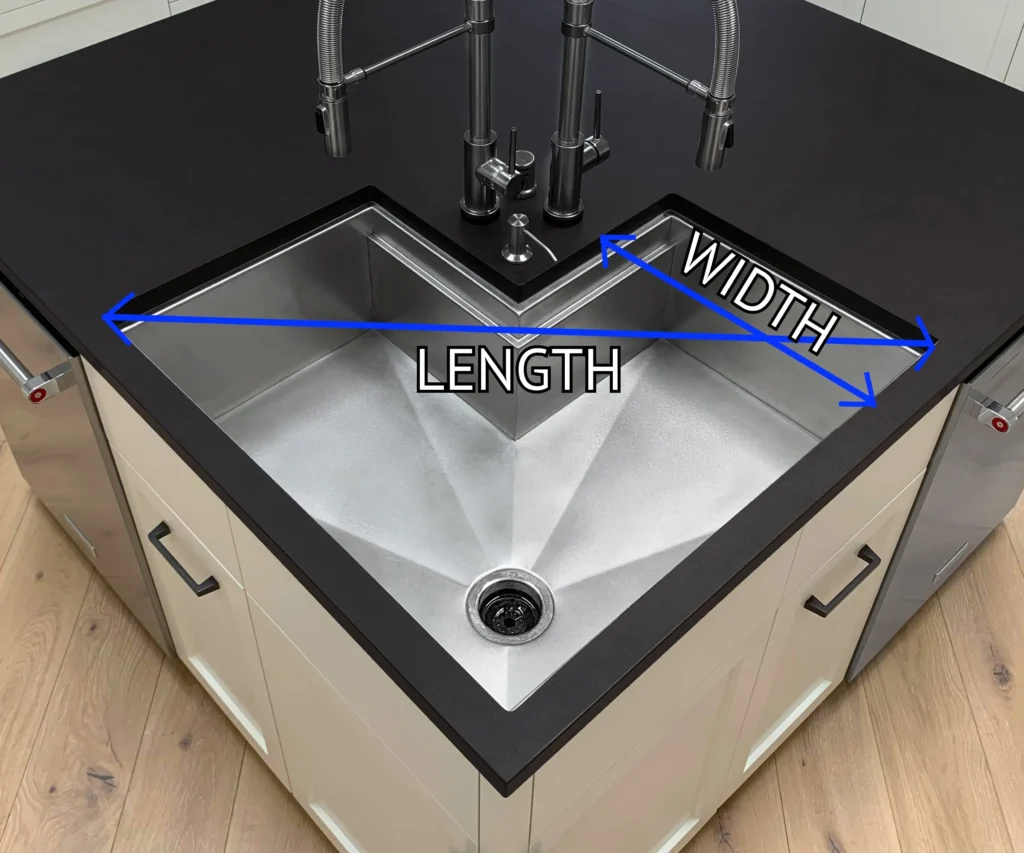
Go deeper
Workflow wins. In an L-kitchen, a corner sink centers your prep zone. Trash to one side, dishwasher to the other, and a cutting board sits over the sink rim. You pivot less. It can also keep the range and fridge clear of a traffic pinch point.
Storage trade-off. The sink base becomes plumbing space. You lose the chance for drawers or pullouts there. You can add shallow tilt trays, a pull-out trash on the adjacent run, or use the far back area for seldom-used tools in labeled bins.
Lighting and comfort. Corners are dark. Plan task lights, a small pendant, or under-cabinet LEDs that wrap the corner. Give yourself elbow room: pull the sink slightly forward so the faucet is reachable without leaning.
Fit checks. Measure dishwasher swing and handle conflicts. If the dishwasher is too close, both doors may collide. Confirm faucet reach against backsplashes that meet at 90°. If windows meet at the corner, check sill height for splash.
When to skip. If you host more than one cook, two prep zones beat one corner sink. If you rely on the base cabinet for big pots, keep it as storage and choose a different corner solution.
Will a tall corner pantry maximize capacity?
Yes. A tall corner pantry swallows bulk goods, small appliances, and cleaning supplies. Swing-out arms or turntables make everything visible. Plan door swing and interior lighting.
Pantries rule where ceiling height is generous and aisles are wide. If your walkway is tight, use slim swing-outs or a diagonal pantry door to reduce conflicts.
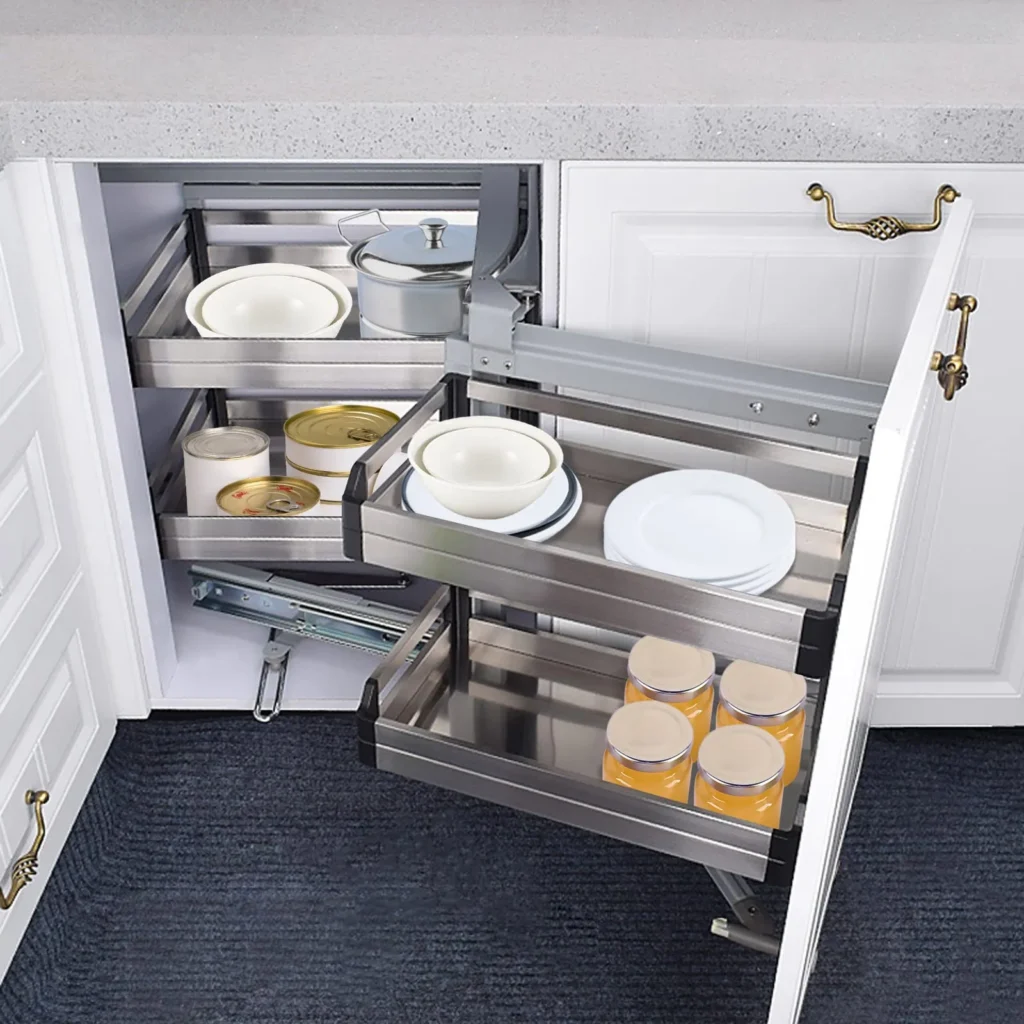
Go deeper
Volume and visibility. A tall pantry turns dead space into cubic feet you can actually use. Swing-out frames bring items to you; turntables handle jars and cans. Add LED strips with a door switch so you never hunt in the dark. Use clear bins and simple labels.
Zoning. Keep daily breakfast items at chest height, baking supplies higher, and backstock on the bottom. Put small appliances (air fryer, blender, rice cooker) on a middle shelf where the cord does not snag. Add a shallow broom nook if the footprint allows.
Door and aisle. A full-width hinged door needs space to open. In tight rooms, consider a bi-fold or a diagonal door across the corner. Check fridge doors nearby; you want both open without a collision.
When it shines. Large families, bulk shoppers, and anyone who wants counters clear. If your corner sits next to a range and the aisle is narrow, a tall pantry may cramp movement; use upper-corner shelves plus a base pullout instead.
Budget tips. Start with simple adjustable shelves. Add swing-outs later when you know what you store most.
Can an appliance garage fit into a corner?
Yes. A corner appliance garage hides toasters, blenders, and a coffee station. Tambour or lift-up doors save space. Add outlets and a shallow tray for drips.
Use it when counters feel messy but you use these appliances daily. Make sure door motion clears upper cabinets and that steam has a path to vent.
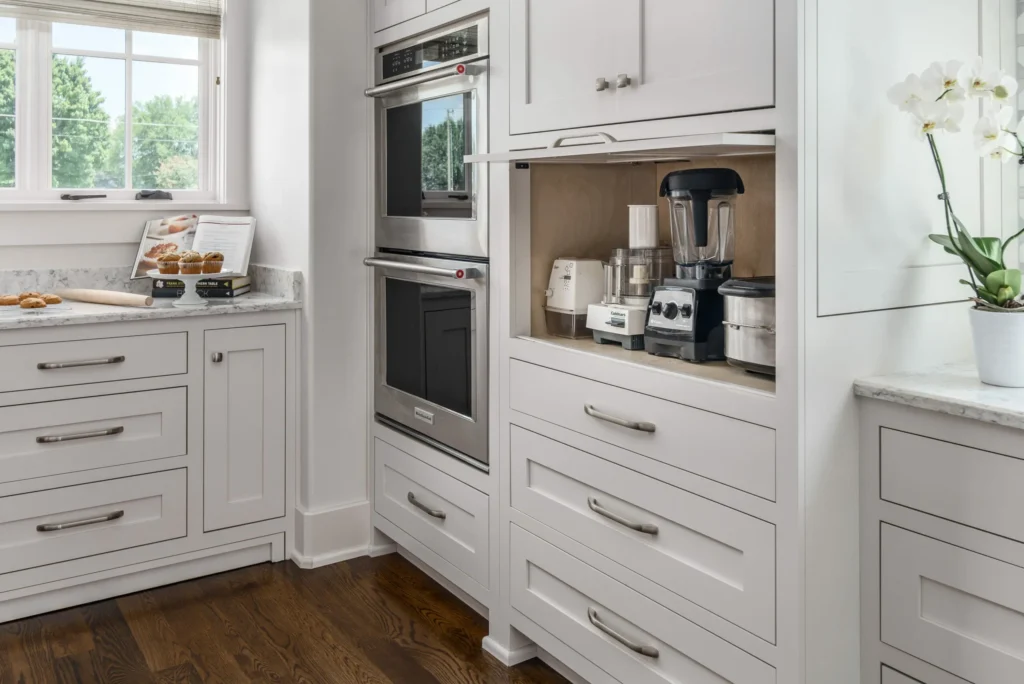
Go deeper
Design basics. A corner garage sits on the counter under uppers. The door can roll up (tambour), flip up, or pocket to the sides. Inside, add a GFCI outlet and a shallow pull-out tray for easy cleaning. A small rail keeps jars from drifting.
Coffee or smoothie zone. Corners suit a coffee station: grinder, machine, mugs, and syrups all in one spot. Or keep blender and protein tubs together for breakfast. A rail of hooks under the upper shelf holds mugs or measuring spoons.
Heat and moisture. Steam from espresso machines and kettles needs space. Leave a gap at the back or add a small vent strip. Wipe condensation and leave the door open for a few minutes after use.
Fit and finish. Check counter depth; some machines are deep. Route cords cleanly through a grommet. Match door style to the rest of the kitchen so the garage looks built-in, not added later.
Why it works. You keep everyday tools out but ready. The corner becomes a neat “station” instead of a dumping ground.
How much do corner cabinet systems cost?
Costs vary by hardware, load rating, and install. Basic trays are cheapest. Pullouts and LeMans units cost more but save time and strain, which matters if you cook daily.
Budget for quality slides and hinges. Cheap parts fail under weight. Measure twice; return fees on specialty hardware can be steep, and mistakes cost more than good planning.
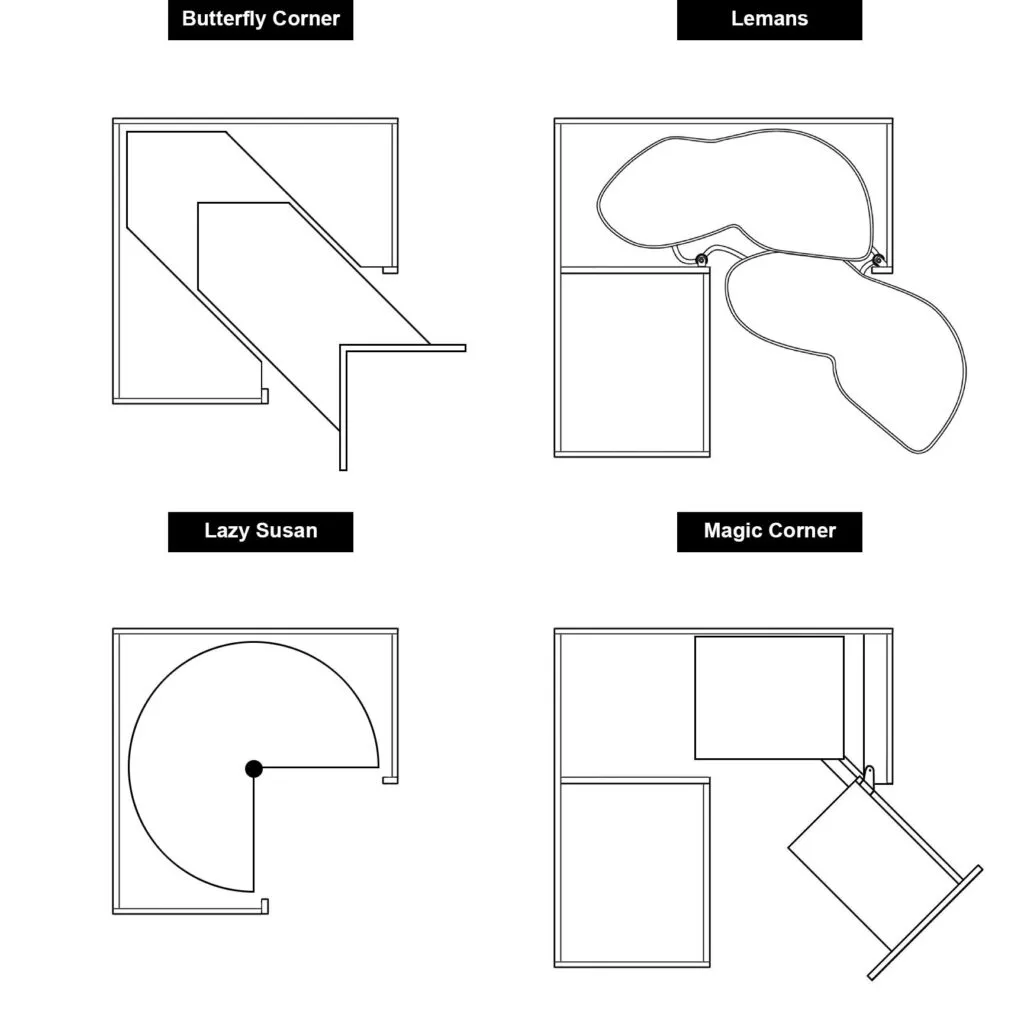
Go deeper
Price bands (typical ranges, hardware only).
| Type | Budget | Mid-range | Notes |
| Classic lazy Susan | Low | — | Entry option; round trays |
| Super Susan | Low–Mid | — | Sturdier; no center pole |
| Half-moon pullouts | Low–Mid | — | Retrofit friendly |
| Blind-corner pullout | Mid | High | Check door/hinge angles |
| LeMans | Mid–High | High | Premium movement & load |
| Magic Corner | Mid–High | High | Great ergonomics; height limits |
| Corner drawers | — | High | Requires precise build |
Install costs. New builds are simpler. Retrofits add labor for shimming, drilling, and hinge changes. Factor electrician time for pantries or appliance garages with lights and outlets.
Value thinking. If you rarely cook, a simple Susan or adjustable shelves may be enough. If you cook daily or have heavy cookware, better hardware pays you back with faster prep and less strain. Buy load ratings you actually need—over-spec costs money; under-spec breaks.
Hidden costs. Door collisions chip paint and crack glass; test clearances with cardboard and tape first. Order soft-close hinges if family members slam doors.
Conclusion
Corners are not a problem space—they are a design choice. Pick motion first, capacity second, then style. Measure carefully, plan lighting, and make your corners work.
FAQ
What can you use instead of a lazy Susan?
Corner drawers, Super Susan shelves without a center pole, blind-corner pullouts, LeMans trays, and half-moon pullouts. These options improve reach, load handling, and day-to-day speed.
Are LeMans corner units worth it?
Often yes for heavy cookware. The trays glide out smoothly, stay level, and bring items fully into view. They cost more but reduce bending and make tight corners usable.
What is the difference between Magic Corner and LeMans?
Magic Corner links multiple trays that slide and pivot together. LeMans uses S-curve trays that swing out individually. Pick based on item height, door clearance, and budget.
What does “blind corner cabinet” mean?
It’s a corner cabinet with hidden, hard-to-reach space. Pullout systems bring contents forward into the light so you can see, lift, and return items without crawling inside.
How do you organize a corner cabinet for maximum storage?
Use clear bins and simple labels. Add tiered turntables for small items, vertical dividers for trays and sheets, and bright LED lighting. Keep daily items front and center.
What minimum opening size does a blind corner need?
Around sixteen inches is a common practical minimum for many pullout kits. Always check the specific hardware requirements for door width, interior depth, and hinge angle.
Do corner pantries need special doors or lighting?
Wide doors or swing-out frames improve visibility and access. Interior LED strips on a door-activated switch help read labels fast and prevent dark spots in deep shelves.

